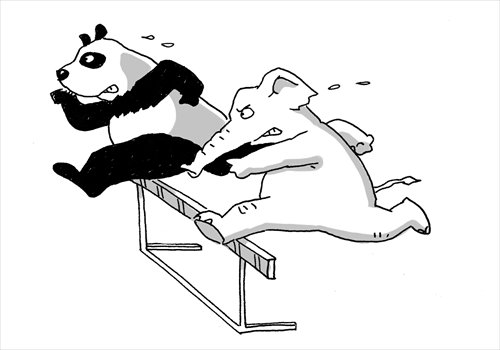HOME >> OP-ED
China and India can complement each other
By Ding Gang Source:Global Times Published: 2015-5-13 23:03:01

Illustration: Liu Rui/GT
Anyone with some geopolitical knowledge understands what revolutionary changes would happen to the political and economic landscape in Asia if China and India could join hands to forge ahead. But people are also aware that there seems always to be a lack of mutual trust between the dragon and the elephant.
China is the world's largest textile exporter, followed by India. The ranking implies where the Sino-Indian relationship stands and unveils one of the reasons for the lack of trust: There is more competition than complementarity.
As the global supply chain has been largely formed today, the lack of economic complementarity between China and India directly leads to a zero-sum game. In other words, one side moving up on the supply chain will likely squeeze the domain of the other.
With regard to manufacturing, China has obviously taken the lead. Although a considerable part of its manufacturers stay in low-end of the chain, China still holds a larger market share than India in most industries, such as textiles, a strong point of both countries, and relevant industries such as equipment and accessories.
The changes to China-India trade structure in recent years originate in the two's different positions in manufacturing. There has been an increase in China's import of raw materials from India and an increase in the export of machinery to India.
This looks much like the trade pattern between China and Latin American countries. Some of them have boosted their economic growth through exports of bulk commodities to China in recent years, but as the Chinese economy moves into a "new normal" and the prices of these bulk stocks drop globally, they are badly hit.
There are similar unsustainable factors in the trade structure of China and India. To tackle them, the two countries must devise and expand the complementarity of their industries.
Some scholars have said that complementarity can be enhanced if China invests more in India's infrastructure. However, this may prove the reverse since better transportation by rail and road will cause more concerns for India about the flooding of Chinese commodities. Besides, it will likely get Chinese enterprises tangled into India's perplexing land system, which may produce unexpected troubles.
The key lies in more industrial coordination. China can make well-planned and targeted industrial transfers in accordance with the development and investment ability of its enterprises and set up production bases in India to make use of its cheaper labor force.
China can also invest more in training selected Indian workers, which can be carried out by the Asian Infrastructure Investment Bank that has started operation. Generally workforce training programs of this kind can easily obtain support from international institutions.
In the meantime, when improving its own underdeveloped industries, India has to take into account of and draw upon China's strength in technology and funding.
The two sides can also provide more favorable conditions for each other's competitive industries. For instance, India can give Chinese telecommunication enterprises more access to local markets if China does likewise for India's pharmaceutical companies. Mergers and acquisitions as well as cooperation should be promoted in the advantageous industries of both sides such as chemical industry and oil refining.
We can learn from the EU's integration that countries can realize complementary cooperation of their developed industries with well-organized competition. But in this process the openness of industries and markets is critical.
In the long run, only with enhanced complementary can China and India have more cooperation and less competition. With the realignment of their industries, they can ultimately create a common market of 2.6 billion people.
The author is a senior editor with People's Daily. He is now stationed in Brazil. dinggang@globaltimes.com.cn. Follow him on Twitter at @dinggangchina
Posted in: Ding Gang, Viewpoint